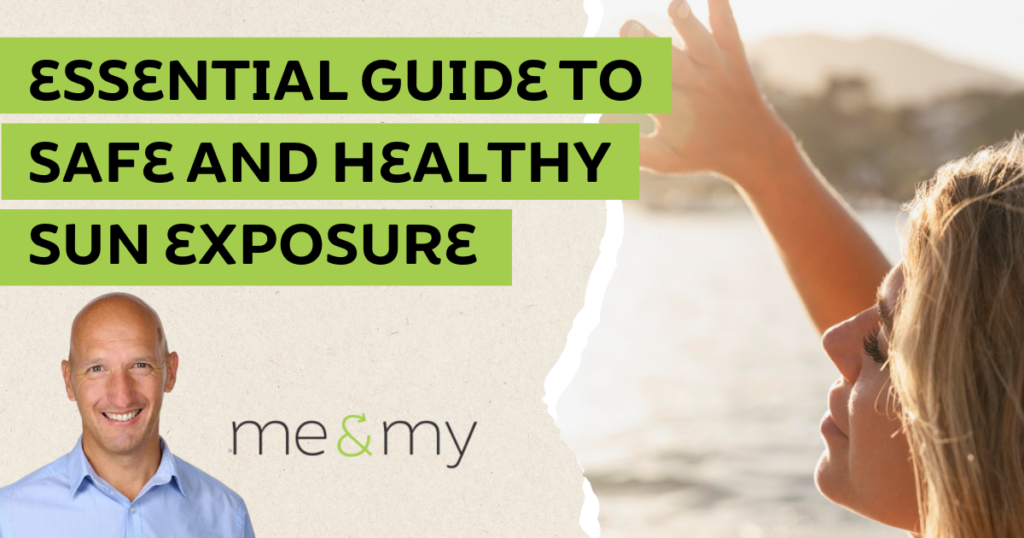Sunlight Myths Debunked: Essential Guide to Safe and Healthy Sun Exposure

Has the sun really become our foe? Amidst alarmist headlines and growing skin cancer awareness, sunlight has unfairly earned a notorious reputation. This blog post aims to untangle fact from fiction, illuminating the true role of sunlight in our well-being and the essential measures we should take to harness its benefits safely.
Inspired by the enlightening discussions on the me&my health up podcast, hosted by Anthony Hartcher, this article delves into the common myths surrounding sunlight exposure. Join us as we explore how to optimally balance our time in the sun, guided by expert insights.
watch the full podcast episode here:
The Role of Sunlight in Regulating Body Functions
Sunlight is crucial for:
- Vitamin D Synthesis: Essential for bone health and immune function.
- Hormone Production: Influences the production of serotonin and melatonin, which regulate mood and sleep patterns.
The Impact of Media Misrepresentation
Media outlets often simplify complex scientific findings into sensational headlines. This has led to a pervasive culture of fear surrounding sunlight, with many believing that any sun exposure is detrimental. It is vital to look beyond the headlines and understand the nuanced truths about sunlight.
Common Myths About Sunlight
Myth 1: All Sun Exposure is Harmful

Truth: While excessive sun exposure can lead to skin damage and increase melanoma risk, moderate sunlight is vital for vitamin D synthesis, mood regulation, and general well-being. It’s about finding the right balance to gain the benefits without risking overexposure.
Myth 2: Avoiding Sun Completely is Healthier

Truth: Insufficient sunlight can result in vitamin D deficiency, weakened immune system, and an increase in certain cancers. Mental health issues such as depression and anxiety are also linked to a lack of natural light. Moderation is essential, not complete avoidance.
Myth 3: All UV Light is Bad

Truth: UV light is essential for many biological processes. Our bodies require controlled exposure to UV for synthesizing essential nutrients and triggering important biochemical reactions. The key is to avoid excessive UV exposure to prevent toxicity.
Optimal Sun Exposure Practices
To make the most of sunlight safely, consider these guidelines:
- Morning Light: Engage in early morning sunlight exposure to help set your circadian rhythm, which enhances sleep quality and hormone regulation. This time of day is low inUV radiation, making it one of the safest times for sunlight exposure.
- Daytime Sunlight: Adjust your sun exposure throughout the day based on your skin type, the season, and environmental conditions to maintain healthy sun practices without overexposure.
The Concept of a Light Diet
Think of sunlight exposure like a diet:
- Regular, moderate exposure: Just as a balanced diet includes a variety of nutrients, a healthy light diet involves a balance of natural light and avoiding excessive artificial ‘junk’ light from screens.
The Dangers of Blue Light
- Blue Light Exposure: Excessive screen time emits narrowband blue light, which can disrupt our body’s natural rhythms, affecting hormone production and potentially leading to insulin resistance and weight gain.
- Breaks from Screens: Regularly stepping away from screens and engaging in outdoor activities can help mitigate the negative effects of blue light.
Daily Recommendations for Sun Exposure
Integrate sun exposure into your daily routine:
- Regular Intervals: Aim to receive about 5 minutes of sunlight every hour, adjusting the duration based on your skin type and the current UV index.
Protective Strategies Against Excessive Sunlight
Safeguard yourself while enjoying the benefits of sunlight:
- Use Sunscreen: Apply sunscreen appropriately when planning prolonged exposure, especially during peak UV hours.
- Wear Protective Clothing: Cover up with hats, sunglasses, and long-sleeved clothing as needed.
- Seek Shade: Utilize natural shade or create your own to reduce direct sun exposure during the midday when UV rays are strongest.
Conclusion
Understanding and dispelling the myths surrounding sunlight allows us to harness its benefits effectively while protecting ourselves from potential risks. By incorporating safe sun exposure practices, we can enhance our health in a balanced and informed manner.
Discover Holistic Health with Me&My Wellness
Interested in optimising your health and well-being through balanced sun exposure? At me&my wellness, we offer holistic health coaching tailored to your unique health goals.
Our expert guidance helps you integrate the power of sunlight into your life effectively and safely. Book a 15-minute FREE consultation with us today and start your journey towards a healthier, more vibrant you.

